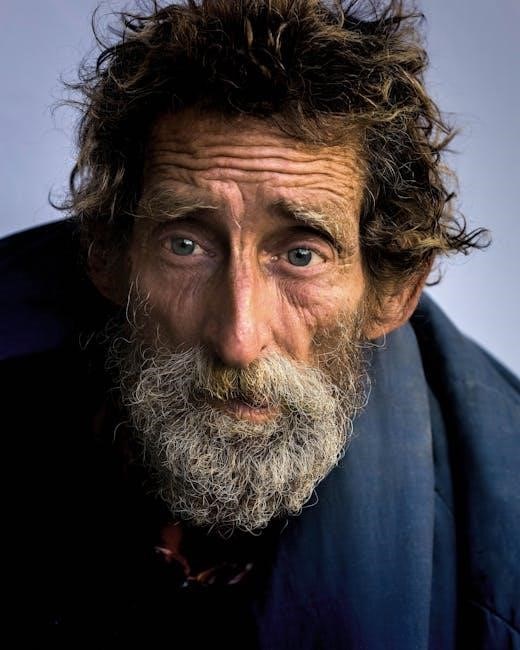Hannah Arendt’s The Human Condition is a foundational work exploring the vita activa, or active life, divided into labor, work, and action․ It examines human existence, political freedom, and agency, offering timeless insights into modernity’s challenges, making it a cornerstone of political and philosophical thought․
Overview of the Book and Its Significance
The Human Condition is a seminal work by Hannah Arendt, first published in 1958, exploring the vita activa and its relevance to modern society․ The book examines human existence through labor, work, and action, emphasizing political freedom and agency․ Its originality lies in its critique of modernity and the diminishing role of the public sphere․ Widely acclaimed, it remains a cornerstone of political philosophy, offering insights into humanity’s capabilities and the paradox of technological advancement․ Its relevance endures, addressing contemporary challenges like alienation and the erosion of human agency․
The Vita Activa and the Vita Contemplativa
Hannah Arendt distinguishes between the vita activa (active life) and vita contemplativa (contemplative life), arguing that the active life is fundamental to human existence․ She critiques the historical dominance of contemplation, tracing its roots to ancient Greek philosophy, which elevated thought over action․ Arendt contends that the active life, comprising labor, work, and action, is essential for human freedom and political engagement․ This distinction forms the core of her analysis, emphasizing the importance of worldly interaction over introspective withdrawal, particularly in the context of modern society’s challenges․
Arendt’s Central Argument: The Active Life
Hannah Arendt’s central argument in The Human Condition is that the active life, or vita activa, is the essence of human existence․ She asserts that true freedom and political agency arise from engaging in the world through labor, work, and action․ Arendt critiques the modern elevation of labor over action, arguing that this shift has diminished human agency and political freedom․ She advocates for a return to the active life, emphasizing the importance of plurality and the public realm in fostering meaningful human interaction and maintaining political freedom․

The Vita Activa: Labor, Work, and Action
The Vita Activa explores labor, work, and action as fundamental human activities․ Labor sustains life, work creates durable objects, and action realizes political freedom and plurality․
Labor: The Biological and Necessary
Labor, as Arendt defines it, is the biological and necessary activity tied to human sustenance and survival․ It is driven by the life process itself, ensuring the continuation of the species through reproduction and consumption․ Labor is cyclical and repetitive, lacking the durability of work or the freedom of action․ Arendt contrasts labor with work and action, viewing it as less noble because it is rooted in necessity rather than creativity or political engagement․ In modernity, labor has become central to human existence, often overshadowing the higher possibilities of action and political freedom, leading to a society dominated by consumption and production․
Work: The Fabrication of the World
Work, as Arendt conceptualizes it, involves the fabrication of the world through creative and deliberate human effort․ Unlike labor, which is driven by biological necessity, work creates durable objects that transcend immediate consumption․ It is through work that humans establish a lasting, artificial environment, distinguishing themselves from nature․ Arendt emphasizes that work is tied to the concept of homo faber, the “man who makes,” whose activities are guided by utility and the desire to create a permanent world․ This realm of work provides stability and permanence, shaping human culture and society․
Action: The Political and the Public Realm
Action, for Arendt, is the highest form of human activity, rooted in political engagement and the public realm․ It involves the free and spontaneous initiation of deeds that establish relationships and narratives․ Unlike labor and work, action is not driven by necessity or utility but by the capacity for plurality and collective enterprise․ The public realm, as the space of appearance, is where action unfolds, fostering human freedom and the creation of shared meaning․ Action, thus, is essential for political freedom and the preservation of the common world․

The Public and Private Realms
Arendt distinguishes between the public realm, where political action and freedom unfold, and the private realm, dominated by necessity and individual interests․ This distinction is central to her analysis of human activity and political life․
The Rise of the Social Realm
The rise of the social realm, as explored in The Human Condition, reflects the encroachment of economic activities and labor into the public sphere; Arendt argues that this realm emerged from the private domain of household and labor, gaining prominence in modernity․ The social realm blurs distinctions between public and private, prioritizing collective welfare over political action․ This shift, driven by capitalism and industrialization, has led to the dominance of “society” as a mediating force, undermining the vitality of the public realm and its capacity for genuine political freedom and human agency․
The Distinction Between Public and Private
Hannah Arendt’s analysis of the public and private realms highlights their historical evolution and interplay․ The public realm, rooted in ancient Greek ideals, represents the space of political freedom, action, and collective deliberation․ In contrast, the private realm encompasses domestic life, labor, and economic activities․ Arendt argues that the modern era has seen the erosion of these distinctions, with the private realm encroaching on the public, leading to the commodification of political life and the loss of authentic public engagement․ This blurring undermines the potential for meaningful political agency and collective action․
The Decline of the Public Sphere in Modernity
Hannah Arendt argues that modernity has led to the decline of the public sphere, as consumer culture and economic interests dominate․ The public realm, once a space for political freedom and collective action, has been eroded by the rise of the social realm, blending private and public concerns․ This shift has diminished political freedom and civic engagement, reducing public life to bureaucratic and economic functions․ Arendt warns that this decline threatens the very foundations of democracy and human agency․

Historical Context and Development
Hannah Arendt traces the evolution of human activities from ancient Greek ideals to modernity, emphasizing the shift from political action to labor and technological dominance․
The Ancient Greek Concept of the Polis
In The Human Condition, Hannah Arendt draws on the ancient Greek concept of the polis, the city-state, as a space of political freedom and human flourishing․ The polis represented the public realm where citizens engaged in discourse, action, and collective decision-making, distinguishing it from the private sphere of labor and household management․ Arendt sees the polis as the embodiment of the vita activa, where human plurality and agency were realized through political action․ This ideal contrasts with modern society’s decline of the public sphere and rise of bureaucratic and technological dominance․
The Christian Middle Ages and the Rise of Labor
Hannah Arendt examines how the Christian Middle Ages redefined human activity, elevating labor as a divine duty․ This period marked a shift from the ancient Greek emphasis on political action to a focus on labor as central to human existence․ Christianity’s valorization of humility and toil transformed labor into a spiritual act, distinguishing it from both work and action․ This theological reframing laid the groundwork for modern society’s prioritization of labor over public-political engagement, altering the human condition and its relationship to the public realm․
The Modern Age and the Triumph of Homo Faber
Hannah Arendt argues that the modern age is characterized by the ascendancy of homo faber, or “man the maker,” whose primary concern is fabrication and productivity․ This era saw the rise of technology and industrialization, which redefined human identity and purpose․ Arendt critiques this shift, asserting that the prioritization of work over action has led to a diminished public realm and political engagement․ The triumph of homo faber has resulted in a society focused on productivity and consumption, undermining the human capacity for meaningful political action and communal life․

Critiques and Challenges to Arendt’s View
Arendt’s ideas have faced criticism for being overly abstract, making them difficult to apply to real-world social issues․ Feminist scholars argue her concepts of labor and work overlook gendered experiences, limiting their universal applicability․
Abstract Nature of Her Ideas
Hannah Arendt’s concepts in The Human Condition have been criticized for their abstract nature, which some argue makes them difficult to apply to real-world social and political issues․ Critics contend that her ideas, while intellectually profound, often lack concrete examples or practical applications․ This abstraction can create a gap between her philosophical framework and the grounded realities of human experience․ Despite their depth, the abstract qualities of her work have led to challenges in translating her theories into actionable solutions for contemporary problems․
Limitations in Addressing Social Issues
While Hannah Arendt’s The Human Condition provides a profound analysis of human activities, it has been critiqued for its limited engagement with specific social issues․ Arendt’s focus on political action and the public sphere sometimes overlooks the complexities of race, gender, and economic inequality․ Her framework, though insightful, does not directly address the lived experiences of marginalized groups, leaving gaps in its application to contemporary social justice movements․ This limitation underscores the need for complementary perspectives to fully capture the diversity of human struggles and aspirations․
Feminist Critiques of Labor and Work
Feminist scholars argue that Hannah Arendt’s distinctions between labor, work, and action often overlook the gendered nature of these categories․ Arendt’s framework, while insightful, fails to adequately address the value of reproductive labor and domestic work, traditionally associated with women․ Critics contend that her emphasis on the public sphere marginalizes private, care-oriented activities, reinforcing gendered divisions․ This oversight limits the universality of her theory, prompting calls for a more inclusive understanding of labor that recognizes the contributions of all individuals, regardless of gender or societal role․

The Relevance of “The Human Condition” Today
The Human Condition remains highly relevant, addressing modern challenges like technological dominance, diminishing agency, and political disengagement, offering timeless insights into humanity’s evolving capabilities and ethical dilemmas․
Diminishing Human Agency
In The Human Condition, Arendt highlights the erosion of human agency in the modern age․ Despite technological advancements, individuals increasingly feel powerless to shape their destinies․ The rise of bureaucratic systems and consumer culture fosters passivity, undermining the capacity for collective action․ Arendt argues that this decline threatens political freedom, as humans become more focused on survival and efficiency than on meaningful engagement with the world․ This diminishing agency reflects a broader alienation from the public realm and the loss of shared purpose in modern society․
The Paradox of Technological Advancement
Arendt identifies a profound paradox in modernity: as human capabilities expand through technology, control over the consequences diminishes․ Technological advancements, while enhancing efficiency, often lead to unintended effects, alienating humans from their actions․ This paradox underscores the tension between progress and understanding, as society becomes increasingly dependent on systems beyond individual comprehension․ Arendt warns that this dynamic erodes human agency, leaving individuals powerless to shape their collective future despite growing technological prowess․
The Enduring Importance of Political Freedom
Hannah Arendt emphasizes the enduring importance of political freedom as a cornerstone of human dignity and agency․ She argues that political freedom, rooted in the public realm, enables individuals to act collectively and shape their shared world․ Arendt warns that modern societies often reduce the public sphere to mere utility, undermining the very essence of freedom․ For Arendt, political freedom is not just a right but a vital means of transcending individual lives and achieving immortality through memorable deeds․ This idea remains central to her philosophy․

Aristotle’s Influence on Arendt’s Thought
Aristotle’s ideas profoundly shaped Arendt’s concepts of plurality, praxis, and the integration of action into political philosophy, reflecting his emphasis on human flourishing and collective life․
The Concept of Plurality
Plurality, a central concept in Arendt’s thought, refers to the fundamental condition of human existence marked by distinctness and diversity among individuals․ She argues that plurality is essential for political action and the formation of a shared public world․ Drawing from Aristotle, Arendt emphasizes that human beings, as plural entities, create meaning through their interactions and narratives․ This concept underscores the importance of diversity in shaping collective life and fostering freedom within the public realm․
The Role of Praxis in Human Life
Praxis, or political action, is central to Arendt’s vision of human life, enabling freedom and the creation of a shared world․ Through praxis, individuals exercise agency, distinguish themselves, and establish meaningful collective narratives․ It transcends mere survival, embodying the highest form of human activity and fostering the public realm’s vitality․ Arendt’s emphasis on praxis highlights its role in shaping political life and human identity, stressing action’s transformative power․
The Integration of Aristotelian Ideas
Arendt deeply incorporates Aristotelian concepts, particularly the notion of plurality and the distinction between the public and private spheres․ Aristotle’s emphasis on the political nature of humans and the importance of praxis influenced Arendt’s framework․ She adapts his ideas to critique modernity’s focus on labor and production, advocating for a revival of political action․ Arendt’s integration of Aristotle’s philosophy underscores the enduring relevance of his thought in understanding human agency, freedom, and the public realm, bridging ancient wisdom with contemporary political theory․

The Structure and Style of the Book
The Human Condition is structured into six main sections, blending philosophical analysis with historical context․ Arendt’s prose is dense yet accessible, emphasizing clarity and depth, making complex ideas engaging for readers while maintaining academic rigor․ Her use of language meticulously shapes key concepts, ensuring precision and intellectual impact throughout the text․
The Division of the Book into Sections
The Human Condition is divided into six main sections, each addressing distinct aspects of the active life․ The book begins with an introduction to the vita activa, followed by sections on labor, work, and action․ It then explores the public and private realms, historical developments, and concludes with the modern age’s impact on human activities․ This structure allows Arendt to systematically analyze the complexities of human existence, ensuring a comprehensive exploration of her central themes․
Arendt’s Use of Historical and Philosophical Analysis
Arendt’s The Human Condition employs a rich historical and philosophical framework to explore human activities․ She draws on ancient Greek concepts, such as the polis, and critiques modernity’s emphasis on labor and production․ By integrating philosophical ideas with historical context, Arendt examines how human experiences of labor, work, and action have evolved․ Her analysis bridges classical thought and contemporary issues, offering profound insights into the nature of human existence and its political dimensions․ This approach underscores her unique ability to connect past and present in understanding human agency and freedom․
The Role of Language in Shaping Concepts
Language plays a crucial role in shaping concepts within The Human Condition․ Arendt emphasizes how terminology influences thought, particularly in distinguishing labor, work, and action․ She draws on etymological insights to trace the evolution of key terms, revealing how language reflects and structures human experiences․ By carefully crafting her vocabulary, Arendt ensures that her philosophical ideas are both precise and evocative, enabling readers to engage deeply with her analysis of human activity and its political implications․ Her linguistic precision underscores the interplay between thought, expression, and understanding․

Key Quotes and Their Interpretation
“The Human Condition of Action” highlights the political realm’s centrality, while “The Labor of Our Body and the Work of Our Hands” contrasts biological necessity with creative fabrication․ These quotes underscore Arendt’s distinctions between labor, work, and action, emphasizing their roles in shaping human existence and political freedom․
“The Human Condition of Action”
In The Human Condition, Hannah Arendt emphasizes action as the highest form of human activity, distinct from labor and work․ Action is rooted in plurality and the public realm, enabling individuals to disclose their unique identities through speech and deeds․ It is inherently political, fostering collective narratives and shaping the world․ Arendt argues that action’s unpredictability and irreversibility make it both fragile and transformative․ This concept underscores the importance of political freedom and human agency in creating meaningful change, highlighting action’s role in sustaining vibrant public spaces and communal life․
“The Labor of Our Body and the Work of Our Hands”
Hannah Arendt distinguishes labor as the biological and necessary activity tied to human survival, driven by the body’s needs․ Unlike work, labor is repetitive and cyclical, producing no lasting objects․ It is rooted in consumption and reproduction, lacking the creativity and durability associated with work․ Arendt argues that labor, while essential, does not transcend the private sphere or create a shared world․ This concept critiques modernity’s elevation of labor over meaningful action, highlighting its limitations in fostering human freedom and agency․
“The Public Realm as the Common”
Hannah Arendt defines the public realm as a shared space where individuals engage in collective action and discourse․ It is the domain of freedom and political agency, where human plurality is realized through dialogue and collaboration․ The public realm contrasts with the private, which focuses on personal interests․ Arendt argues that the erosion of the public sphere in modernity threatens democracy, as it diminishes the capacity for shared understanding and communal action, essential for sustaining a vibrant political life and fostering human dignity․
Hannah Arendt’s The Human Condition remains a vital exploration of human existence, emphasizing the importance of political freedom and agency in sustaining a meaningful public life․
The Legacy of “The Human Condition”
The Human Condition has left an enduring legacy in political philosophy, influencing scholars and theorists․ Its exploration of labor, work, and action continues to shape discourse on human agency and the public sphere, offering insights into contemporary issues like technological advancement and political freedom․ The book’s relevance endures, making it a cornerstone for understanding modern challenges to human existence and the necessity of active political engagement․
Its Impact on Political and Social Theory
The Human Condition profoundly influenced political and social theory by redefining key concepts like action, labor, and work․ Arendt’s distinction between the public and private realms reshaped debates on democracy and civic engagement․ Her critique of modernity’s focus on labor and consumption challenged traditional Marxist and liberal frameworks, offering a new perspective on human agency and the role of politics in fostering freedom and plurality․
Final Thoughts on the Book’s Relevance
The Human Condition remains a vital text for understanding modern society’s complexities․ Arendt’s exploration of labor, work, and action offers insights into contemporary issues like technological advancement and political disengagement․ Her emphasis on plurality and the public realm underscores the importance of collective action and democratic participation․ As a foundational work in political philosophy, it continues to inspire new generations of thinkers, urging a reclamation of human agency and the pursuit of freedom in an increasingly complex world․

References and Further Reading
Primary sources include Hannah Arendt’s The Human Condition (1958)․ Secondary sources offer scholarly analyses, while online archives like the Internet Archive provide free access to the text․
Primary Sources
The primary source for studying Hannah Arendt’s ideas is her book The Human Condition (1958), published by the University of Chicago Press․ The second edition, released in 1989, includes an introduction by Margaret Canovan and an expanded index․ This edition is widely regarded as the definitive version, offering a comprehensive exploration of the vita activa and its divisions into labor, work, and action․ The book is structured into six main sections, each delving into themes such as the public and private realms, the rise of the social, and the implications of modernity․ Digital versions, including PDFs, are available through academic databases and online archives like the Internet Archive, making Arendt’s seminal work accessible to global readers․ The text remains a cornerstone of political philosophy, continuing to inspire scholarly and public discourse․
Secondary Sources and Scholarly Articles
Scholarly articles and secondary sources provide critical insights into Hannah Arendt’s The Human Condition․ Works by Seyla Benhabib and Lewis P․ Hinchman offer feminist and philosophical analyses, while Samantha Rose Hill explores the book’s contemporary relevance․ These sources examine Arendt’s distinctions between labor, work, and action, as well as her critiques of modernity․ Academic journals and essays are available online, offering in-depth discussions of her ideas and their implications for political theory and social thought; These resources are essential for understanding the book’s intellectual impact and enduring significance․
Online Resources and Archives
Online resources and archives provide accessible ways to explore The Human Condition․ The Internet Archive offers a free PDF version of the book, enabling global access to Arendt’s seminal work․ Additionally, digital libraries and academic platforms host study guides, essays, and analyses by scholars like Seyla Benhabib and Samantha Rose Hill․ These resources include introductions by Margaret Canovan, enhancing understanding of Arendt’s concepts․ Online archives also feature discussions on the book’s relevance, making it easier for readers to engage with its ideas and historical context․

